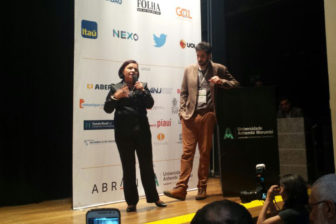
Editor’s Note: The Brazilian Association of Investigative Journalism is one of GIJN’s largest, most dynamic member organizations. Known locally as the Associação Brasileira de Jornalismo Investigativo, or ABRAJI, the group played host to GIJN’s largest ever gathering, with 1,350 people gathered for the 8th Global Investigative Journalism Conference in 2013. This year, as Abraji marks its 15th anniversary, the association is launching an ambitious project — to use its members to investigate and continue the work of threatened and murdered journalists across Brazil. Inspired by The Arizona Project four decades earlier, Abraji’s new effort could be a model for other countries.
The 977 participants of the 12th International Congress of Investigative Journalism, held earlier this month, set a record for the Brazilian Association of Investigative Journalism (Abraji) as it celebrated its 15-year anniversary.
Originally created to assist with the professional development of journalists and the spread of investigative reporting concepts and techniques, the association celebrated its largest congress so far with more than 70 panels and 150 speakers in São Paulo.
“We began with the desire to be journalists, to make good stories and to do better,” said Thiago Herdy, president of Abraji, according to the association. “I experienced this for the first time ten years ago at a congress like this, and I was sure that I wanted to be a journalist myself.”
Topics included data journalism, investigations of commerce, business models, education coverage, entrepreneurship and gender in journalism, among others. The main event was a talk with the editor of The Washington Post, Martin Baron, which was moderated by Knight Center founder and director Rosental Calmon Alves.
O jornalista @PostBaron , ex-chefe da equipe Spotlight e hoje no @washingtonpost , fala agora no #congressoabraji #abraji pic.twitter.com/aOzip5stUM
— Ana Clara Costa (@anaclaracosta) July 1, 2017
In addition to being “just a newspaper,” Baron said the Post is becoming a technology and information company, announcing the hiring of 30 professionals in video production. Baron also said that the U.S. press has faced the greatest pressure since the time of Richard Nixon, and yet current President Donald Trump uses even harsher language against journalists.
The event also served as a platform to announce the Tim Lopes Project, a tribute to the kidnapped reporter who was killed in 2002. The 15-year-old case had a severe impact on the Brazilian press and was the motivation for the creation of Abraji. This year, the organization intends to establish a rapid-reaction protocol for any future deaths of other colleagues.

Tim Lopes’ sister, Tania Lopes, and Thiago Herdy, president of Abraji, talk about the new Tim Lopes Project for journalists. (Alessandra Monnerat/Knight Center)
Whenever a journalist is murdered or prevented from practicing his profession in Brazil, a pool of experienced reporters from different outlets will be assembled to accomplish two missions: investigate and report on the incident and/or death of the colleague and continue the interrupted work.
“We want to show that you cannot kill journalists in Brazil,” Herdy told the Knight Center. “It is important that [people] know that ‘Tim has arrived,’ that the press is there and that it is a strong institution. This can serve as an inspiration for tackling violence against the press in other countries.”
The initial phase of the project, which still in production, is a series of documentaries on the deaths of four other Brazilian journalists. The reports by Bob Fernandes and documentary filmmaker João Wainer‘s team are expected to be released in the second half of this year.
The association wants to be sure they are present mainly in regions which are far from the main centers of the country, where most press murders take place. Brazil is one of the deadliest countries in the world to be a journalist, according to the Committee to Protect Journalists.
The project originates from an idea from journalist Marcelo Beraba, Abraji’s first president, and is inspired by the Arizona Project from the U.S.-based Investigative Reporters and Editors. The original initiative followed the murder of reporter Don Bolles in Phoenix, Arizona, in 1976.
For Beraba, a project like this illustrates the growth of Abraji and, consequently, the improvement of the training of Brazilian journalists and the culture of collaboration among newsrooms in the country.
“At the beginning of Abraji, we were not in a position to do such a project,” Beraba told the Knight Center. “We had the problem of funding, of not having a collaborative culture in newsrooms. And repeating the Arizona Project at the Complexo do Alemão [the Rio favela where Tim Lopes was killed] would have been an irresponsible risk. The association then sought to improve the quality of our training, to defend freedom of expression and freedom of access to information.”
The 12th International Congress of Investigative Journalism was supported by the Knight Center for Journalism in the Americas.
This article originally appeared on the Journalism in the Americas blog of the Knight Center for Journalism in the Americas and is cross-posted here with permission.
 Alessandra Monnerat was an international student from Pontifical Catholic University of Rio de Janeiro (PUC-Rio), Brazil, studying journalism at the University of Texas at Austin in 2016. During her time at UT, she volunteered at the Knight Center as a blogger and researcher. She hopes to pursue a career in human rights journalism.
Alessandra Monnerat was an international student from Pontifical Catholic University of Rio de Janeiro (PUC-Rio), Brazil, studying journalism at the University of Texas at Austin in 2016. During her time at UT, she volunteered at the Knight Center as a blogger and researcher. She hopes to pursue a career in human rights journalism.
